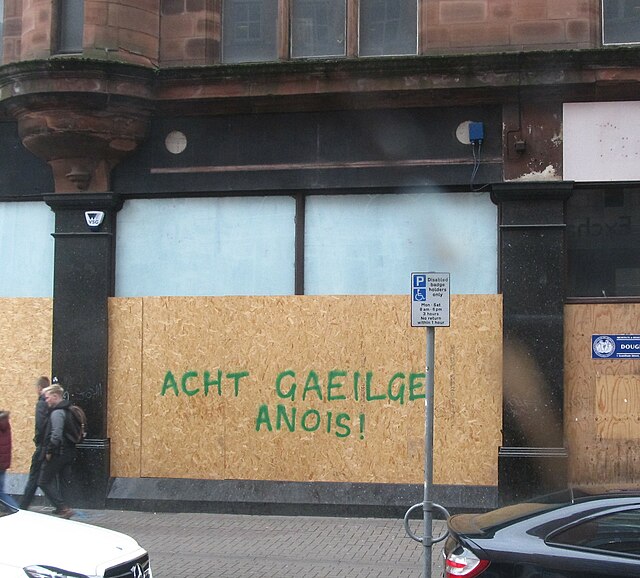On November 23rd, Lady Gaga released ‘The Fame Monster’, a repackaging of her previous and first hit album ‘The Fame’, plus 8 more tracks collectively and tellingly entitled ‘Monster’. First Lady Gaga found the secret to fame, and now, like a wild-styled, hip-gyrating Dr. Frankenstein, she gets to mess around with the grotesque pop culture icon she created in her own image.
How to describe the Gaga Monster? YouTube’s heismanBEAST may be sum it up best: in response to a video posted of Lady Gaga performing ‘Paparazzi’ on the MTV Video Music Awards in September, heismanBEAST observes succinctly, “She is a good singer but she dresses and acts weird”.
Indeed.
At the end of the performance in question, Lady Gaga (real name Stefani Joanne Angelina Germanotta, 22) had already performed a lush and dynamic pop routine, and with (fake) blood pouring down her middle Carrie-esque, she had herself hanged from the rafters. To top it all off, later accepting her own VMA for Best New Artist Lady Gaga wore head-to-toe red lace complete with a face-covering headpiece that she doffed for her speech (during which she thanked both ‘God and the gays’). In the context of her recent performance, the red lace appeared more gorey than glamorous.
Observed angelbrimhall on YouTube, “dang she is bloody o.m.g. she is gross”.
Of course, for every ‘weird’or ‘gross’ she elicits on YouTube, Gaga also gets an ‘amazing’, ‘cool’, or ‘soo unique’. She’s already got a cover on Rolling Stone (June, 2009), for which she posed semi-nude, clad only in plastic bubbles.
But unlike so many other artists who have tried to mix the ‘weird’ or the ‘gross’ with the ‘popular’ and ‘cool’, Lady Gaga has managed to impress both the critics and the fans with her idiosyncratic style, publicity-mongering, and – yes – her artistic vision.
Even if it weren’t commonly known that she studied at the Tisch School for the Arts at New York University, the proof is in the pudding (or maybe the muffin) that Gaga is the auteur of her own pop perfection. It helps that she has the credentials, if not the actual degree, of being Tisch-affiliated, but just watch a selection of any two or three Lady Gaga music videos and it is clear from the continuity of musical and visual styles on display throughout that there are some serious Themes (with a capital ‘T’ for artistic pretension’s sake) being worked out here.
Her first album ‘The Fame’ is about a self-conscious desire or need for popular recognition and approval. As she sings in ‘Paparazzi’: ‘I’ll follow you until you love me’ – addressing both the love interest in the song/video, her public/fans outside the video, and the paparazzi both within and without the video at the same time. It is, perhaps, the most ‘meta’ of her songs within the album, when compared to the relatively basic pop fare of ‘Just Dance’ and the racy ‘Love Game’.
Standard as they may sound when played on the radio, however, singles like ‘Just Dance’, ‘Love Game’, and ‘Poker Face’ are performed quite differently by the onstage Lady Gaga than by the radio-and-video Lady Gaga. Gaga on tour is appealingly – and, it would seem, intentionally – rough around the edges. Her voice (and it her voice, live), no longer studio-smooth produced, is rich, even rock-raspy at times. Instead of performing burlesque-inspired dance moves like in many of her videos (she was an actual burlesque dancer for years), she stamps the floor and flails about the stage. Performing ‘Poker Face’ on Jonathan Ross this autumn, Gaga looked and acted more like Karen O of the Yeah Yeah Yeahs than Christina Aguilera, to whom she was compared and often mistaken for in her early days.
Left to her own devices onstage, the lady is a vamp.
So if this is the raw, unfiltered Gaga – the artist performing directly to the audience – is this then the ‘real’ Gaga? Indie, avant-garde, performance artist Gaga? It would mean that the decadent pop star persona has been bait all along, luring us into her weird and wonderful world of the grotesque and all-consuming meta-artistry.
…That’s a phrase you don’t see often in YouTube comments. But that’s also not to say it isn’t there. Without making a qualitative judgment of either end of the spectrum, positive responses to Lady Gaga range from those of pop interest to the intensely academic. Online you can find a lengthy essay on the occult imagery used in the music video for Gaga’s latest single, ‘Bad Romance’.
For the record, I found no explanation for the weird gold things on that guy’s cheeks.
That’s a gripe, but it’s also the essence of Lady Gaga’s cultural significance. She turns something simple and globalized – the pop star icon – into something ambiguous, even uncanny. We’ve seen it all before – in Madonna, Bowie, Queen (from whose song ‘Radio Ga Ga’ she got her name) – but in Lady Gaga it’s all just short of familiar.
Lady Gaga comes to Dublin this winter and is scheduled to play the O2 on the 1st of February, 2010. Until then, she can be seen making the MTV rounds in ‘Bad Romance’, and, as ever, on YouTube, fashion blogs, arts and culture blogs, blogs about blogs, and probably coming soon to doctoral thesis on meta-performativity.






